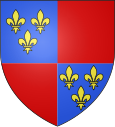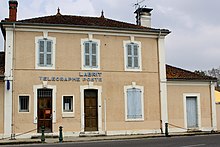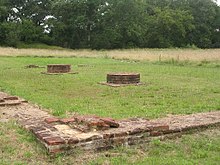Labrite
| Labrite | ||
|---|---|---|

|
|
|
| region | Nouvelle-Aquitaine | |
| Department | Country | |
| Arrondissement | Mont-de-Marsan | |
| Canton | Haute Lande Armagnac (main town) | |
| Community association | Cœur Haute Lande | |
| Coordinates | 44 ° 6 ′ N , 0 ° 33 ′ W | |
| height | 70-113 m | |
| surface | 72.18 km 2 | |
| Residents | 864 (January 1, 2017) | |
| Population density | 12 inhabitants / km 2 | |
| Post Code | 40420 | |
| INSEE code | 40135 | |
 town hall |
||
Labrit is a French municipality with 864 inhabitants (at January 1, 2017) in the department of land in the region Nouvelle-Aquitaine (before 2016: Aquitaine ). It belongs to the arrondissement of Mont-de-Marsan and the canton of Haute Lande Armagnac (until 2015: canton of Labrit ).
The settlement was called Albretum in Gallo-Roman times and the aristocratic family of the Albret family has their roots here. The name is derived from the Gascognischen word bret ( German rabbit ).
The inhabitants are called Labritois and Labritoises .
geography
Labrit is about 25 km north of Mont-de-Marsan in the historic province of Gascony .
Labrit is surrounded by the neighboring communities:
| Luxey | Read | |
| Sabers |

|
Cache |
| Vert | Brocas | Bélis |
Labrit lies in the catchment areas of the Adour and Eyre rivers .
The Estrigon , a tributary of the Midouze , crosses the territory of the municipality, as does its tributaries, which have their source in Labrit,
- the Ruisseau de Mégnot,
- the Ruisseau de Bernin,
- the Ruisseau de Bernède and
- the Ruisseau de Biensang.
The Ruisseau de l'Escamat, also known as the Ruisseau de Taringat on the upper reaches, is a tributary of the Eyre and has its source in Labrit, as does the Barade de Brigaille and the Ruisseau de la Lagune, tributaries of the Ruisseau de Laste.
history
The remains of a villa are evidence of the settlement in Gallo-Roman times. The parish became famous in the Middle Ages for being home to the Albrets, one of the most powerful families in the southwest. Relics of their castle can still be seen today. The members of the family became seigneurs of the surrounding lands before their power expanded to the entire region. Jeanne d'Albret married the King of Navarre in the 16th century and their son became the French King Henry IV. In 1536 Labrit was the capital of the Duchy and Pairie der Albrets. In the Second Empire a policy of drainage developed in the country, as the region was considered a wild land. Jules Chambrelent and Henri Crouzet, engineers of the Ponts et Chaussées , were commissioned to plant pines . With their wood they could now collect tree sap and make pillars for mines and railways. Forestry became the determining economic factor in the community.
Labrit owned a station on the railway line that connected Mont-de-Marsan with Luxey and opened in 1906. In 1955 the transport of people was stopped, in 1959 the freight transport.
Population development
After records began, the population rose to a high of around 1,270 at the beginning of the 20th century. In the period that followed, the size of the community fell to around 665 inhabitants during short recovery phases until the 1990s, before a phase of growth began that increased the size to over 800 inhabitants, but has recently stagnated again.
| year | 1962 | 1968 | 1975 | 1982 | 1990 | 1999 | 2006 | 2010 | 2017 |
|---|---|---|---|---|---|---|---|---|---|
| Residents | 815 | 757 | 682 | 699 | 666 | 715 | 825 | 874 | 864 |
Attractions
Parish Church of Saint-Médard
The former parish church of Labrit was first mentioned in the scriptures in 1285. It had a nave with a nave with wall cladding, a bell gable and a flat apse . Despite several works in the 19th century, in which u. a. When a sacristy was added, the church was judged to be inadequate and in too bad a condition. It was therefore demolished after 1893, and a new church was built in neo-Gothic style between 1886 and 1888 according to plans by the architect of the diocese , Jules François Dupouy, and consecrated to Saint Medardus of Noyon . Some of the building materials from the old structure were reused. The present church has three naves with a length of six Jochen designed. The main nave is extended by a choir , which is flanked by two sacristies. To the west, a square bell tower rises out of the building with narrow polygonal stair towers on either side. An entrance portal with an ogival tympanum leads to the anteroom on the ground floor of the bell tower. A lot of space above the entrance portal lets light into the interior. A gallery rises above the main nave. This is equipped with a ribbed vault , which rests on round pillars, and is illuminated by high, ogival glass windows. The capitals of the column and the services are sculptured with leaves and crabs . The keystones in the main nave are marked with the Agnus Dei , the coat of arms of Pope Leo XIII. , the coat of arms of Bishop Delannoy von Aire , a chalice and a stole and two rosettes . The church building is built with plastered quarry stone , with the exception of the bell tower, which was built with ashlar . The roofing is made of interlocking tiles with the exception of the octagonal masonry tower . Buttresses run around the entire church.
The church has only taken over a few items from the furniture of the previous church. The most notable of these are a wooden statue and bas-relief from the 18th century depicting Saint Medardus and Saint Anthony , the primary and secondary patrons of the parish church. The 160 cm high statue of Medardus shows him at a young age and without a beard in episcopal clothing, cassock , choir shirt made of linen and lace , stole, cope and miter . In his left hand he carries a crook , the right one is raised to bless. The statue probably occupied a niche in the retable of the main altar of the earlier church. The four-part relief is set in a gilded frame. It shows Saint Anthony kneeling in penance with one hand on his chest. A skull, an open book and a bell can be seen on a rock next to him, on the left a crucifix at the entrance to a grotto , behind him his attribute , the pig. A landscape with valley and mountains can be seen in the background. The relief originally occupied the altarpiece on the main altar of the earlier church.
Eight stained glass windows are works by the glass painter Gustave Pierre Dagrant from Bordeaux , which were created in 1893 when today's church was being built. In addition to geometric representations, they show the following biblical people, motifs and symbols:
- the motif of the heart of Jesus ,
- the apostle Peter
- Saint Paul with a sword,
- Saint Medardus,
- St. Joseph ,
- Saint Anthony praying in his hermitage ,
- the preaching of the Lord and
- in a rose window a dove as a symbol of the Holy Spirit framed by the four evangelists and the four Latin church fathers .
Castle ruins
The first castle was built around 1127 using the site's building materials, clay and wood. Amanieu VII of Albret added a stone castle in the eastern part of the courtyard between 1310 and 1320. The castle ruins were demolished in 1820. Since March 16, 1988, the area has been inscribed as a monument historique .
Cenotaph to commemorate the fallen in World War I.
Robert Wlérick created the monument in 1922, which is placed near the parish church. It consists of a flat stele on which a statue rests, depicting a mother with her daughter wearing the traditional headscarf. On each side a relief shows the profiles of a young and an old Poilu . The monument has been inscribed as Monument historique since October 21, 2014 .
Economy and Infrastructure
Trade and services are the main economic drivers of the community.

total = 100
education
The municipality has a public pre-school with 61 pupils in the 2017/2018 school year and a college since September 2015 .
sport and freetime
- Labrit is located in the Landes de Gascogne Regional Nature Park .
- A circular route with a length of 39 km leads from the center of Labrit by bike through the territory of the municipality.
traffic
Labrit can be reached via the routes départementales 57, 392, 626 and 651.
Web links
- Labrit on the website of the association of municipalities (French)
- Landes de Gascogne Regional Nature Park website (French)
Individual evidence
- ↑ a b Labrit ( fr ) Conseil régional d'Aquitaine. Archived from the original on September 9, 2016. Retrieved on May 13, 2018.
- ↑ Landes ( fr ) habitants.fr. Retrieved May 13, 2018.
- ↑ Ma commune: Labrit ( fr ) Système d'Information sur l'Eau du Bassin Adour Garonne. Retrieved May 13, 2018.
- ↑ Description of the line Luxey / Mont-de-Marsan ( fr ) Voies ferrées des Landes. Retrieved June 23, 2018.
- ↑ Notice Communale Labrit ( fr ) EHESS . Retrieved May 13, 2018.
- ↑ Populations légales 2006 Commune de Labrit (40135) ( fr ) INSEE . Retrieved May 13, 2018.
- ↑ Populations légales 2015 Commune de Labrit (40135) ( fr ) INSEE . Retrieved May 13, 2018.
- ↑ église paroissiale Saint-Médard ( fr ) Ministry of Culture and Communication . Retrieved May 13, 2018.
- ↑ le mobilier de l'église paroissiale Saint-Médard ( fr ) Ministry of Culture and Communication . Retrieved May 13, 2018.
- ^ Statue: Saint Médard ( fr ) Ministry of Culture and Communication . Retrieved May 13, 2018.
- ^ Bas-relief: Saint Antoine ermite ( fr ) Ministry of Culture and Communication . Retrieved May 13, 2018.
- ↑ ensemble de 8 verrières: Sacré-Coeur, Saint Pierre, Saint Paul, Saint Médard, Saint Joseph, Saint Antoine ermite en prière, Annonciation, Saint-Esprit avec les Evangélistes et les Docteurs de l'Eglise (baies 0 à 6, 101 ) ( fr ) Ministry of Culture and Communication . Retrieved May 13, 2018.
- ↑ Château des Albret ( fr ) chateau-fort-manoir-chateau.eu. Retrieved May 13, 2018.
- ^ Château de Labrit, dit d'Albret ( fr ) Ministry of Culture and Communication . Retrieved May 13, 2018.
- ^ Monument aux morts de la guerre 1914-1918, situé près de l'église ( fr ) Ministry of Culture and Communication . Retrieved May 13, 2018.
- ↑ Caractéristiques des établissements en 2015 Commune de Labrit (40135) ( fr ) INSEE . Retrieved May 13, 2018.
- ^ Landes (40), Labrit ( fr ) National Ministry of Education. Retrieved May 13, 2018.
- ↑ En images, l'inauguration du 38e collège des Landes à Labrit ( fr ) Sud Ouest . September 1, 2015. Accessed May 13, 2018.
- ↑ 51 communes du Parc Naturel Regional des Landes de Gascogne ( fr , PDF) Parc Naturel Régional des Landes de Gascogne. Archived from the original on March 3, 2016. Info: The archive link was inserted automatically and has not yet been checked. Please check the original and archive link according to the instructions and then remove this notice. Retrieved May 13, 2018.
- ↑ A Labrit "Parfums de landes" ( fr ) Comité Départemental du Tourisme des Landes. Retrieved May 13, 2018.






